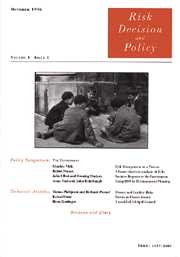No CrossRef data available.
Article contents
Expected utility and the cumulative consequences of repeated decisions: a tutorial
Published online by Cambridge University Press: 25 June 2002
Abstract
Utility theory as developed by Von Neuman and Morgenstern provides an elegant way to make consistent choices among risky alternatives by maximizing the expected value of a personal utility function over known probability distributions of outcomes. The theory is usually presented in the context of a single (possibly complex) decision, where it gives little guidance on the choice of a utility function. This paper provides a tutorial on the consequences of applying expected utility theory to repeated decisions, using theory and simulation to reveal the statistical regularity arising cumulatively from repeatedly applying the same utility. If decisions are repeated and consequences accumulate, two utility functions stand out as maximizing cumulative incremental growth and cumulative compound growth, namely the linear utility and the logarithmic utility, respectively. Repeatedly basing decisions on the linear utility when compound growth applies and severe losses are possible can be disastrous in the long term. Relevance to financial investment and population catastrophes is considered.
- Type
- Technical Paper
- Information
- Copyright
- © Risk Decision and Policy, 2002




